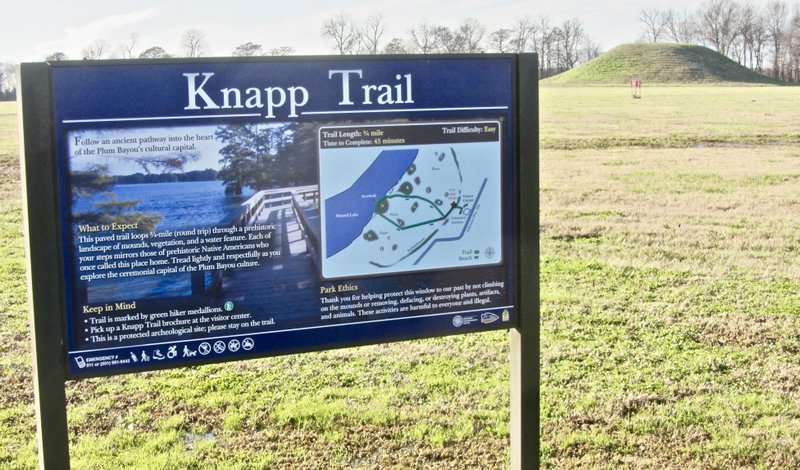TOLTEC MOUNDS ARCHEOLOGICAL STATE PARK — Among the oldest visible markers of human civilization in present-day Arkansas are three grass-covered mounds rising from a riverside plain less than an hour southeast of downtown Little Rock.
A millennium or more old, they are impressive enough that 19th-century Arkansans imagined they had been constructed by the Toltecs of prehistoric Mexico. That wildly misguided notion presumed a lack of building skills by predecessors of the "primitive" local American Indians. In fact, these rather mysterious Plum Bayou people (as they are now labeled) did the necessary work while here from the 7th to 11th centuries.
Today's visitors to Toltec may need a helping hand of background information to grasp how special these ancient remnants are. Details are displayed at the visitor center, with additional material posted along the site's two trails. In today's digital cosmos, a primer to check out before heading to Toltec is posted by the Arkansas Department of Parks and Tourism at arkansasstateparks.com/toltecmounds/.
This online fare includes a brisk video summary by Amy Griffin, a seasoned park interpreter. In a snappy minute, she highlights Toltec's main features and its unique niche in our region's long-long-ago past. She also supplies printed comments labeled as "5 Fun Facts." With advance arrangements, she or another interpreter conducts walking tours when weather permits.
Walking the Knapp Trail, the shorter of two marked paths at three-quarters of a mile, gives a close-up look at the layout. According to the trail's brochure, "Archeologists believe only about 50 people lived within the boundaries of this site. These individuals are thought to have been the religious and civic leaders of the Plum Bayou people. The general population, it is believed, lived in scattered villages and farmsteads in the surrounding area."
In that sense, the local big shots created some early semblance of a gated community. They dwelt in privacy behind a 10-foot-high earthen wall. It's likely, according to the brochure, that only several times a year would ordinary citizens have been admitted "for special ceremonies and to renew social and family ties."
Of the 18 original mounds that have been detected, only three still stand tall, while most of the others have been leveled by farming in modern times. The tallest, labeled Mound A and rising to 49 feet, is flat on top and believed to have served as a platform for a temple or house. Mound B, 39 feet high, probably had a similar function.
The third, Mound C, is much lower and rounded on top. Archaeologists determined decades ago that it is a burial site, making it off-limits for digging under a 1991 state law that forbids any disturbing of American Indian graves.
To the eyes of a visitor without any background knowledge, the three mounds look pretty much like grass-covered piles of dirt, with scant remains of an earthen wall below.
Interpreter Griffin's details flesh out the prehistoric scene to the extent possible, given the absence of any written evidence. She imagines the labor needed to erect Mound A, high as a five-story building and the tallest American Indian structure of its kind in Arkansas:
"To build this massive mound, the two most important tools were a digging stick, which was burnt on the end and a basket for hauling the dirt. Since tall, flat-topped mounds have been identified as platform mounds, we believe it could have been an area used to hold a hut to live in and/or to conduct ceremonies."
This question and much else about the Plum Bayou People remain elusive — and likely will stay so even as archaeological methods become more sophisticated. But informed visitors can gain at least a sketchy sense of daily life here before the Plum Bayou people moved away or died off — four centuries or more before the first European explorers showed up in future Arkansas.
Toltec Mounds Archeological State Park
Where: Arkansas 386 off U.S. 165 between Scott and Keo.
Hours: 8 a.m.-5 p.m. Tuesday-Saturday, noon-5 p.m. Sunday.
Admission: Free for the visitor center’s exhibit gallery or a self-guided walking tour. Guided walks arranged in advance cost $4 per adult, $3 per child 6-10. Tours in a tram also can be arranged in advance by calling (501) 961-9442.
Style on 01/28/2020
